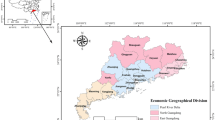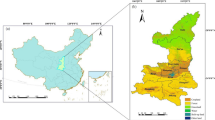Abstract
In the process of China’s modernization, promoting the sustainable development of resource-based cities is a major strategic issue and it has now also become a worldwide issue. This study uses the coupling model to validate the coupling relationship between China’s land-use net carbon flux and economic growth and population change during 2009–2017. The study for the first time draws the conclusion that the coupling degree among the three is getting lower, the correlation is gradually weaker, and the independent relationship is becoming more and more prominent. Utilizing the Tapio decoupling model, we obtained the weak decoupling conclusion that the economic growth rate is higher than the growth rate of the land-use net carbon flux, while negative decoupling of sprawl is where the rate of population growth is less than the rate of net land-use carbon flux growth.
Similar content being viewed by others
Data availability
The datasets used and/or analyzed during the current study are available from the corresponding author on reasonable request.
References
Cai Z, Tsuruta H, Gao M, Xu H, Wei C (2003) Options for mitigating methane emission from a permanently flooded rice field. Glob Change Biol 9:37–45
Carlson KM, Gerber JS, Mueller ND, Herrero M, MacDonald GK, Brauman KA, Havlik P, O’Connell CS, Johnson JA, Saatchi S, West PC (2017) Greenhouse gas emissions intensity of global croplands. Nat Clim Change 7(1):63–68. https://doi.org/10.1038/nclimate3158
Carter AP (1966) The economics of technological change. Sci Am 214:25–31
Collins AM, Haddaway NR, Macura B, Thomas J, Randall N, Taylor JJ, Cooke S, Gilbert A (2019) What are the impacts of within-field farmland management practices on the flux of greenhouse gases from arable cropland in temperate regions? A systematic map protocol. Environ Evidence 8(1):38. https://doi.org/10.1186/s13750-019-0182-2
Duan X, Wang X, Lu F, Ouyang Z (2008) Carbon sequestration status and potential of wetland ecosystems in China. J Ecol 28:7
Fu BT, Wu M, Che Y, Yang K (2017) Effects of land-use changes on city-level net carbon emissions based on a coupled model. Carbon Manag 8:245–262
Geng Y, Dong Y, Meng W (2000) Research progress of terrestrial carbon cycle. Progress Geogr Sci 19:10 in Chinese
Gitz V, Ciais P (2003) Amplifying effects of land-use change on future atmospheric CO2levels. Global Biogeochem Cycles 17:44–48+121
Gurney KR, Liang J, Roest G, Song Y, Mueller K, Lauvaux T (2021) Under-reporting of greenhouse gas emissions in US cities. Nat Commun 12:553
Harper AB et al (2018) Land-use emissions play a critical role in land-based mitigation for Paris climate targets. Nat Commun 9:2938
Hosonuma N, Martin H, De Sy V, De Fries RS, Brockhaus M, Verchot L, Angelsen A, Romijn E (2012) An assessment of deforestation and forest degradation drivers in developing countries. Environ Res Lett 7(4):044009. https://doi.org/10.1088/1748-9326/7/4/044009
Houghton RA, House JI, Pongratz J, van der Werf GR, DeFries RS, Hansen MC, Le Quéré C, Ramankutty N (2012) Carbon emissions from land use and land-cover change. Biogeosciences 9(12):5125–5142. https://doi.org/10.5194/bg-9-5125-2012
Houghton RA, Nassikas AA (2017) Global and regional fluxes of carbon from land use and land cover change 1850–2015. Global Biogeochem Cycles 31:456–472
Hurtt GC, Chini L, Sahajpal R, Frolking S, Bodirsky BL, Calvin K, Doelman JC, Fisk J, Fujimori S, Klein K, Tomoko G, Peter H, Andreas H, Florian H, Johan H, Jungclaus JO, Kaplan J, Tamás K, David K, Peter L, Lei L, Ole M, Mertz J, Pongratz A, Popp B, Keywan P, Riahi E, Elke S, Peter S, Thornton FN, Tubiello DP, van Vuuren Xin, Zhang (2020) Harmonization of global land use change and management for the period 850–2100 (LUH2) for CMIP6. Geosci Mod Dev 13(11):5425–5464. https://doi.org/10.5194/gmd-13-5425-2020
Jingyun F, Guohua L, Songling X (1996) Biomass and net production of forest vegetation in China. Acta Ecologica Sinica, 497-508 in chinese
Kuang W, Liu J, Dong J, Chi W, Zhang C (2016) The rapid and massive urban and industrial land expansions in China between 1990 and 2010: a CLUD-based analysis of their trajectories, patterns, and drivers. Landsc Urban Plan 145:21–33
Lai L, Huang X (2005) Study on ecological footprint evaluation of national land use planning objectives. J Agric Eng 21:66–71 in Chinese
Li P, Liu L, Wang J, Wang Z, Wang X, Bai Y, Chen S (2018) Wind erosion enhanced by land use changes significantly reduces ecosystem carbon storage and carbon sequestration potentials in semiarid grasslands. Land Degrad Dev 29:3469–3478
McCalmont JP, McNamara NP, Donnison IS, Farrar K, Clifton-Brown JC (2017) An interyear comparison of CO2flux and carbon budget at a commercial-scale land-use transition from semi-improved grassland toMiscanthus x giganteus. GCB Bioenergy 9:229–245
Mendoza-Vega J, Messing I, Ku-Quej VM, Pool-Novelo L, Chi-Quej J (2021) Land evaluation and carbon flux estimation to reinforce natural protected areas: a case study in Southern Mexico. Environ Earth Sci 80(3):78. https://doi.org/10.1007/s12665-021-09369-0
Miao Z, Chen Y (2020) Study on the relationship between economic growth, population change and net carbon flux of land use – an empirical analysis of 45 years of historical data between China and the United States. Ecol Econ 36:34–38+67 in Chinese
Montgomery DR (2007) Soil erosion and agricultural sustainability. Proc Natl Acad Sci U S A 104:13268–13272
Peylin P, Law RM, Gurney KR, Chevallier F, Jacobson AR, Maki T, Niwa Y, Patra PK, Peters W, Rayner PJ, Rödenbeck C, van der Laan-Luijkx IT, Zhang X (2013) Global atmospheric carbon budget: results from an ensemble of atmospheric CO<sub>2</sub> inversions. Biogeosciences 10:6699–6720
Pongratz J, Reick C, Raddatz T, Claussen M (2008) A reconstruction of global agricultural areas and land cover for the last millennium. Glob Biogeochem Cyc 22(3):n/a-n/a. https://doi.org/10.1029/2007GB003153
Pugh TAM, Lindeskog M, Smith B, Poulter B, Arneth A, Haverd V, Calle L (2019) Role of forest regrowth in global carbon sink dynamics. Proc Natl Acad Sci U S A 116:4382–4387
Rjoub H, Odugbesan JA, Adebayo TS, Wong W-K (2021) Investigating the causal relationships among carbon emissions, economic growth, and life expectancy in Turkey: evidence from time and frequency domain causality techniques. Sustainability 13:2924
Schwalm CR, Huntzinger DN, Michalak AM, Schaefer K, Fisher JB, Fang Y, Wei Y (2020) Modeling suggests fossil fuel emissions have been driving increased land carbon uptake since the turn of the 20th Century. Sci Rep 10:9059
Searchinger T, Heimlich R, Houghton RA, Dong F, Elobeid A, Fabiosa J, Tokgoz S, Hayes D, Yu TH (2008) Use of U.S. croplands for biofuels increases greenhouse gases through emissions from land-use change. Science 319:1238–1240
Semieniuk G, Taylor L, Rezai A, Foley DK (2021) Plausible energy demand patterns in a growing global economy with climate policy. Nat Clim Chang 11:313–318
Shi H, Mu X, ZhangLv YM (2012) Study on carbon emission effects of different land use types in Guangyuan City, Sichuan Province. Water Soil Conserv Bullet 32:101–106 in Chinese
Su Y, Zhang Y (2011) Study on carbon emission benefits of land use change in Shaanxi Province. Water Soil Conserv Bullet 25:5 in Chinese
Sun Y, Ji H, Luo J, Li T, Jiang Y (2006) Research progress on climate driven carbon cycle of terrestrial ecosystem in China. J Cap Normal Univ (Natural Science Edition) 27:90–95 in Chinese
Tapio P (2005) Towards a theory of decoupling: degrees of decoupling in the EU and the case of road traffic in Finland between 1970 and 2001. Transp Policy 12:137–151
Terrell TD (2020) Carbon flux and N- and M-shaped environmental Kuznets curves: evidence from international land use change. J Environ Econ Policy 10:155–174
UNEP (2019) Emissions gap report 2019. United Nations Environment Programme, Nairobi. https://wedocs.unep.org/bitstream/handle/20.500.11822/30797/EGR2019.pdf?sequence=1&isAllowed=y. Accessed 26 Nov 2019
van Groenigen KJ, Qi X, Osenberg CW, Luo Y, Hungate BA (2014) Faster decomposition under increased atmospheric CO(2) limits soil carbon storage. Science 344:508–509
Vehmas J, Luukkanen J, Kaivo-oja J (2007) Linking analyses and environmental Kuznets curves for aggregated material flows in the EU. J Clean Prod 15:1662–1673
Walsh B, Ciais P, Janssens IA, Penuelas J, Riahi K, Rydzak F, van Vuuren DP, Obersteiner M (2017) Pathways for balancing CO2 emissions and sinks. Nat Commun 8:14856
Wang Z, Hoffmann T, Six J, Kaplan JO, Govers G, Doetterl S, Van Oost K (2017) Human-induced erosion has offset one-third of carbon emissions from land cover change. Nat Clim Chang 7:345–349
Wang J, Feng L, Palmer PI, Liu Y, Fang S, Bosch H, O’Dell CW, Tang X, Yang D, Liu L, Xia C (2020) Large Chinese land carbon sink estimated from atmospheric carbon dioxide data. Nature 586:720–723
Xiaofeng X, Hanqin T, Shiqiang W (2007) Impact of climate warming on carbon cycle of terrestrial ecosystems. J Plant Ecol 175–188 in chinese
Xu G, Liu Z, Jiang Z (2006) Factor decomposition model and empirical analysis of China’s carbon emissions: 1995–2004. China’s Popul Resources Environ 16:158–161 in Chinese
Yan Q, Kumar P, Wang Y, Zhao Y, Lin H, Ran Q, An Z, Zhou W (2020) Sustainability of soil organic carbon in consolidated gully land in China’s Loess Plateau. Sci Rep 10:16927
Zhao X, Taheripour F, Malina R, Staples MD, Tyner WE (2021) Estimating induced land use change emissions for sustainable aviation biofuel pathways. Sci Total Environ 779:146238
Zhou Y, Zhang J, Hu S (2021) Regression analysis and driving force model building of CO2 emissions in China. Sci Rep 11:6715
Zhu K, Song Y, Qin C (2019) Forest age improves understanding of the global carbon sink. Proc Natl Acad Sci U S A 116:3962–3964
Ziteng C, Jinming Y, Fen G (2016) Research on the relationship between land use carbon emissions and economic growth -- A case study of Liuzhou City. Acta Ecol Sin 32:87–89 in chinese
Author information
Authors and Affiliations
Contributions
Y.H. and R.L. provided data and writing ideas. X.H. helped to organize the data and completed the main part of the thesis. Professor. Y.S. helped to organize the data and completed the first and second parts of the text. F.L. provided a lot of help in language editing. W.C. and X.D. also provided financial support for data collection and language editing.
Corresponding author
Ethics declarations
Ethics approval
Not applicable.
Consent to participate
Not applicable.
Consent for publication
Not applicable.
Competing interests
The authors declare no competing interests.
Additional information
Responsible Editor: Ilhan Ozturk
Publisher's note
Springer Nature remains neutral with regard to jurisdictional claims in published maps and institutional affiliations.
Xianke Huang, Yujie Huang, and Ruiliang Li contributed equally to this work.
Supplementary Information
Below is the link to the electronic supplementary material.
Rights and permissions
Springer Nature or its licensor (e.g. a society or other partner) holds exclusive rights to this article under a publishing agreement with the author(s) or other rightsholder(s); author self-archiving of the accepted manuscript version of this article is solely governed by the terms of such publishing agreement and applicable law.
About this article
Cite this article
Huang, X., Huang, Y., Li, R. et al. Decoupling of land-use net carbon flux, economic growth, and population change in China. Environ Sci Pollut Res 30, 107058–107067 (2023). https://doi.org/10.1007/s11356-023-25335-8
Received:
Accepted:
Published:
Issue Date:
DOI: https://doi.org/10.1007/s11356-023-25335-8




